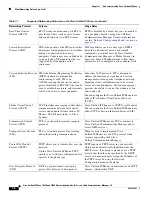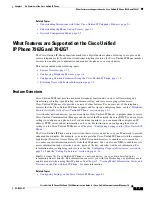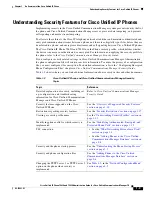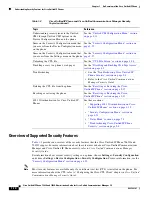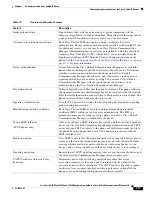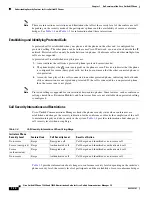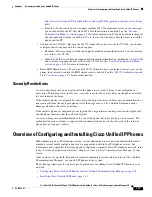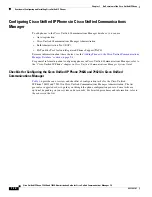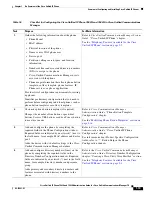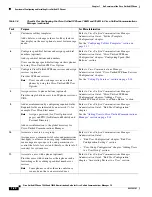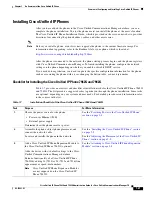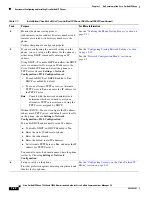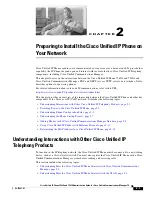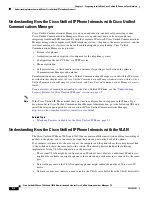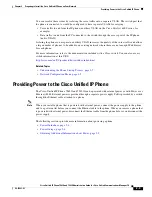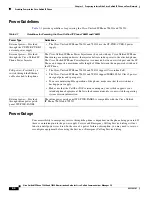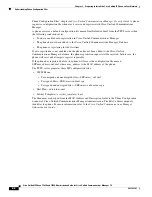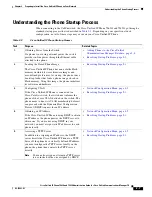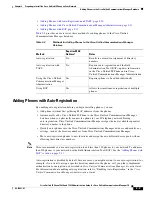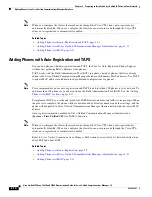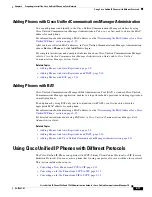
1-20
Cisco Unified IP Phone 7962G and 7942G Administration Guide for Cisco Unified Communications Manager 7.0
OL-15483-01
Chapter 1 An Overview of the Cisco Unified IP Phone
Overview of Configuring and Installing Cisco Unified IP Phones
5.
Customize softkey templates.
Adds, deletes, or changes order of softkey features
that display on the user’s phone to meet feature usage
needs.
Refer to
Cisco Unified Communications Manager
Administration Guide
, “Softkey Template
Configuration” chapter.
See the
“Configuring Softkey Templates” section on
page 5-17
.
6.
Configure speed-dial buttons and assign speed-dial
numbers (optional).
Adds speed-dial buttons and numbers.
Users can change speed-dial settings on their phones
by using Cisco Unified CM User Options.
Refer to
Cisco Unified Communications Manager
Administration Guide
, “Cisco Unified IP Phone
Configuration” chapter, “Configuring Speed-Dial
Buttons” section.
7.
Configure Cisco Unified IP Phone services and assign
services (optional).
Provides IP Phone services.
Note
Users can add or change services on their
phones by using the Cisco Unified CM User
Options.
Refer to
Cisco Communications Manager
Administration Guide
, “Cisco Unified IP Phone Services
Configuration” chapter.
See the
“Setting Up Services” section on page 5-18
.
8.
Assign services to phone buttons (optional).
Provides single button access to an IP phone service or
URL.
Refer to
Cisco Unified Communications Manager
Administration Guide
, “Cisco Unified IP Phone
Configuration” chapter, “Adding a Cisco
Unified IP Phone Service to a Phone Button” section.
9.
Add user information by configuring required fields.
Required fields are indicated by an asterisk (*); for
example, User ID and last name.
Note
Assign a password (for User Options web
pages) and PIN (for Extension Mobility and
Personal Directory)
Adds user information to the global directory for
Cisco Unified Communications Manager.
Refer to
Cisco Unified Communications Manager
Administration Guide
, “End User Configuration”
chapter.
See the
“Adding Users to Cisco Unified Communications
Manager” section on page 5-18
10.
Associate a user to a user group.
Assigns users a common list of roles and permissions
that apply to all users in a user group. Administrators
can manage user groups, roles, and permissions to
control the level of access (and, therefore, the level of
security) for system users.
Refer to
Cisco Unified Communications Manager
Administration Guide
:
•
“End User Configuration” chapter, “End User
Configuration Settings” section
•
“User Group Configuration” chapter, “Adding Users
to a User Group” section.
11.
Associate a user with a phone (optional).
Provides users with control over their phone such a
forwarding calls or adding speed-dial numbers or
services.
Note
Some phones, such as those in conference
rooms, do not have an associated user.
Refer to
Cisco Unified Communications Manager
Administration Guide
, “End User Configuration”
chapter, “Associating Devices to a User” section.
Table 1-6
Checklist for Configuring the Cisco Unified IP Phone 7962G and 7942G in Cisco Unified Communications
Manager (continued)
Task
Purpose
For More Information

